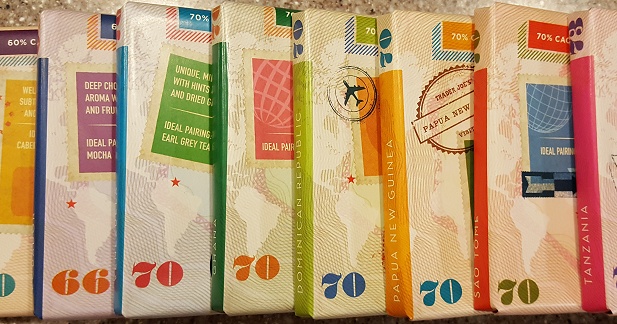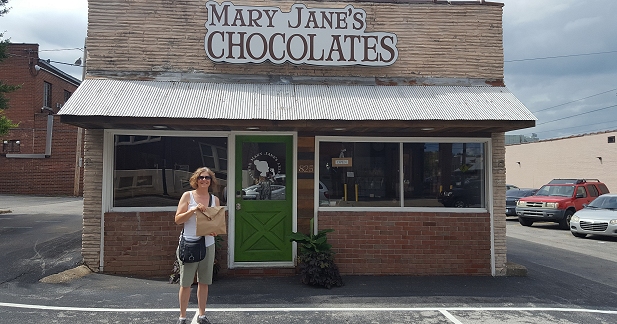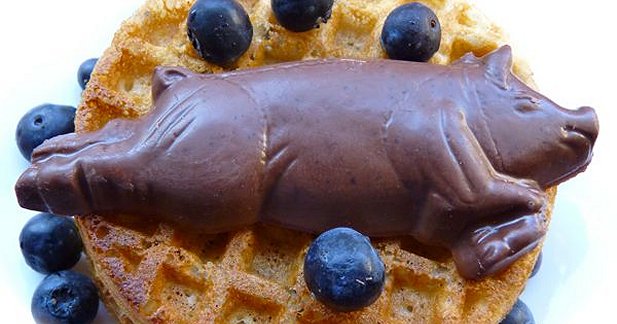chocolate education

Trader Joe’s Chocolate Passport
February 6, 2017
This blog post marks the beginning of my series on single-origin chocolates from Trader Joe’s Chocolate Passport variety pack.
Each week I will review one of these country of origin chocolates: Peru 60%, Ecuador 66%, Ghana 70%, Venezuela 70%, Dominican Republic 70%, Papua New Guinea 70%, Sao Tome 70%, and Tanzania 73%.

Mary Jane’s Chocolates: Origine Bars – Saint Dominique and Mexique
September 19, 2016
Last week I wrote a review on Mary Jane's Chocolates dark chocolate coated dried cherries. While I was in the chocolate shop, a great opportunity presented itself. I found something tasty AND educational -- chocolate melting wafers based on a single-source country of origin.
This is very exciting for me!
Read more

Divine, Cheese, and Wine!
January 4, 2016
A friend of mine, Amanda, recently moved into new a home. “I’ll bring the wine and cheese”, says my friend Kathy. “I’ll bring the chocolate”, I say, “Why don’t we pair the chocolate with the wine and see what happens?”
They agreed to the plan, but confessed to not having much experience consuming the two at the same time. However, being lovers of both chocolate and wine, they couldn’t see a downside. This would be an opportunity to eat, drink wine, and experiment – a few of our favorite activities!

Will It Chocolate? Funny Video Friday!
October 23, 2015
Good morning, and Happy Friday from CUO!
As you know, we're all fun and games in the world of chocolate. Today, we bring you a video that has an extra dose of funny chocolate humor.
This video is a gem. It made me literally LOL!

The CUO Chocolate Survey – We Want To Know!
August 28, 2015
Here at CUO, we're always learning about chocolate, and all things pertaining to the rich, dark, wonderful substance.
Now, we want to learn from YOU! Read more

The Versatility of Chocolate
October 3, 2014
I’ve been eating a different chocolate each day for more than eight years. I love the unadulterated flavor notes in a well-made single origin chocolate bar. However, I’ve also come to admire the amazing versatility of cacao after blending different chocolates with fruits, nuts, spices, beverages and savory items over time.
What makes good flavor blends in food? Fresh ingredients, and a skillful mix of the five basic tastes--salty, sweet, bitter, sour, umami (meaty, savory)--are two considerations. And these do apply to chocolate as well.
Q&A: What’s the Big Deal About Lecithin?
August 22, 2014
Recently a reader asked me the following question. It's a good one, so I wanted to answer here on the blog...
What is the big deal about soy lecithin and if most artisan producers manage to do without it, why don't all chocolatiers?
The big deal about soy lecithin is a combination of science and economics.
Read more
Chocolate Travel for CUO Graduate School
June 24, 2013
I am really excited to announce our first ever CUO Chocolate Immersion which will take place at Walt Disney World® Resort, February 7-12, 2014. If you have already taken our classes, then consider this your "graduate school."
How To Fully Enjoy Your Chocolate
April 5, 2013
"Mindful eating goes beyond eating," said Lilian Cheung, a registered dietitian, co-author of Savor: Mindful Eating, Mindful Life, and director of health promotion and communication at the Harvard School of Public Health in Boston, Massachusetts.
You can easily be more mindful if you opt for high-quality chocolate and check the label before buying. You can get an instant idea regarding the sweetness or bitterness of chocolate by understanding the chocolate to sugar ratio.
"If you buy chocolate with a higher cocoa content, it will be less sweet," said Stephen Durfee, a pastry chef instructor at the Culinary Institute of America at Greystone, in St. Helena, California. "You will get more of the natural flavor of chocolate."
Dutch-Process vs Natural Cocoa Powder
May 24, 2012
There are a lot of variations of cocoa powder. Two of the most prominent types around the world are the Dutch-processed cocoa powder and natural cocoa powder.
Dutch-processed cocoa powder is made from cocoa beans that have been treated with a potassium solution. That neutralizes the acidity of the cocoa beans.
On the other hand, natural cocoa powder is derived from the cocoa beans that have been simply roasted and then reduced and pulverized into a fine powder.
Read more


